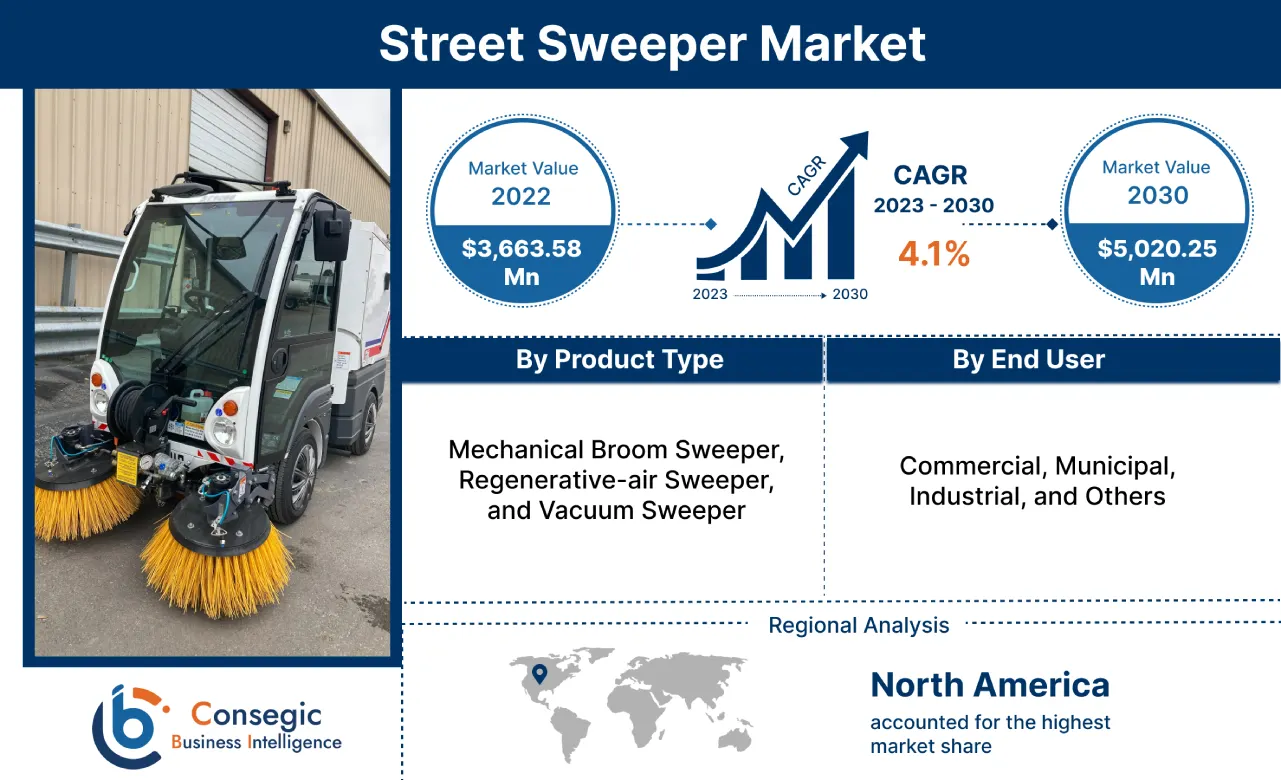Street Sweeper Market Size :
Consegic Business Intelligence analyzes that the Street Sweeper Market size is growing with a CAGR of 4.1% during the forecast period (2023-2030), and the market is projected to be valued at USD 5,020.25 Million by 2030 from USD 3,663.58 Million in 2022.
Street Sweeper Market Scope & Overview:
Street sweepers are specialized vehicles or machines designed to clean and maintain the cleanliness of public roads, streets, highways, parking lots, and other paved surfaces. The main purpose of these sweepers is to remove debris, dirt, leaves, and other unwanted materials from streets or other paved surfaces.
The street sweeper market includes various types of machines such as vacuum sweepers, regenerative air sweepers, mechanical sweepers, and surface scrubbers. In addition, the market analysis shows that they come in various forms and sizes, ranging from small, compact machines used for urban areas to larger, truck-mounted sweepers for highways and larger roadways.
Street Sweeper Market Insights :
Street Sweeper Market Dynamics - (DRO) :
Key Drivers :
Growing public health concerns have augmented the growth of the street sweeper market
Street sweepers play a vital role in maintaining cleanliness and hygiene in urban areas, thereby contributing to improved public health. They help to reduce the amount of dust, particulate matter, and allergens present on roads and pavements, in turn resulting in air quality improvement. In addition to this, regular street sweeping eliminates potential breeding sites and reduces the risk of disease transmissions such as dengue, malaria, and various bacterial infections.
For instance, according to the statistics published by the National Center for Vector Borne Diseases Control (NCVBDC), in India, the number of malaria cases amounted to 161,753 in 2021 and rose to 176,522 in 2022. Therefore, as public health concerns continue to rise, this requirement has increased to ensure a healthier environment for residents. As per the market analysis, growing public health concerns have augmented the street sweeper market demand.
Rise in implementation of government regulations towards environmental sustainability
Government regulations related to environmental protection, waste management, and public health often require municipalities and local authorities to maintain clean and debris-free streets. Street sweepers are specifically designed to remove litter, dust, leaves, and other debris from road surfaces, sidewalks, and public spaces.
Moreover, the growing emphasis on sustainability and green initiatives further contributes to the market. For instance, the Department of Streets and Sanitation (DSS) in Chicago is one of the largest non-emergency departments with a team of over 2,000 employees and a USD 283 Million annual budget. In addition, the 2030 Agenda for Sustainable Development, adopted by all United Nations Member States in 2015 is another significant factor contributing to the growing need for sanitation, in turn, propelling the street sweeper market demand.
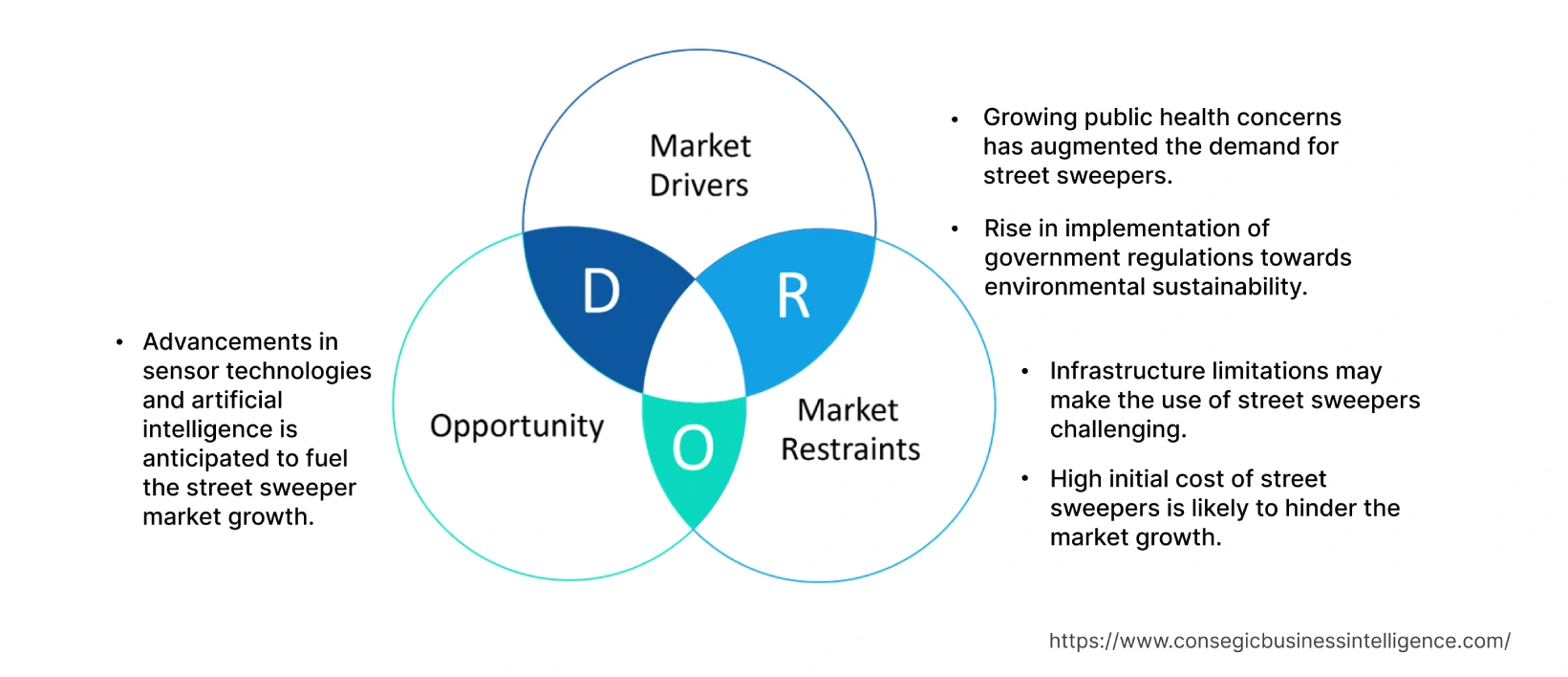
Key Restraints :
Infrastructure limitations may make the use of street sweepers challenging
Various factors such as narrow streets, congested areas, infrastructure design, and obstacles can impact the operation and efficiency of street sweeping equipment. Street sweepers require adequate space to maneuver and access the areas to be cleaned. Restricted space can hinder their ability to make turns, reach curbsides, and clean along the edges of the street. These factors may result in municipalities considering alternative sweeping solutions such as manual sweeping methods. Therefore, as per the market trends analysis, the aforementioned factors are likely to deter the growth of street sweepers in some regions, in turn, limiting the street sweeper market growth.
The high initial cost of street sweepers is likely to hinder the street sweeper market
The high cost and significant upfront investment can deter potential buyers and limit market growth. As a result, smaller municipalities or organizations with limited budgets may opt for less expensive cleaning methods such as manual sweeping or contracting third-party services. High investment costs may discourage small-scale contractors from investing in these machines. Hence, the street sweeper market analysis depicts that the factors mentioned above may restrict the street sweeper market growth.
Future Opportunities :
Advancements in sensor technologies and artificial intelligence are anticipated to fuel the street sweeper market
The integration of artificial intelligence (AI) and sensor technologies enables advanced features such as obstacle avoidance, and automatic adjustment of brush settings, among others. These capabilities improve the overall performance and reliability of street sweepers, reducing operational costs and increasing their lifespan. For instance, Enway, a BUCHER company, has launched CityCat V20e, an autonomous sweeper machine made for driverless outdoor sweeping. As per the market trends analysis, technological advancements and contributions by key players operating in the market will further bolster the street sweeper market opportunities over the forecast period.
Street Sweeper Market Report Insights :
| Report Attributes | Report Details |
| Study Timeline | 2017-2030 |
| Market Size in 2030 | USD 5,020.25 Million |
| CAGR (2023-2030) | 4.1% |
| By Product Type | Mechanical Broom Sweeper, Regenerative-air Sweeper, and Vacuum Sweeper |
| By End User | Commercial, Municipal, Industrial, and Others |
| By Region | North America, Europe, Asia-Pacific, Latin America, and Middle East & Africa |
| Key Players | Global Environmental Products, BUCHER, FAYAT Group, Aebi Schmidt Group, Piquersa Maquinaria, S.A., Nilfisk Group, Hako Machines Ltd, Çeksan, Alamo Group Inc., FULONGMA GROUP Co., Ltd., and Alfred Kärcher SE & Co. KG |
Street Sweeper Market Segmental Analysis :
By Product Type :
The product type segment is trifurcated into mechanical broom sweepers, regenerative-air sweepers, and vacuum sweepers. In 2022, the mechanical broom sweeper segment accounted for the highest market share of the total street sweeper market share. They have traditionally been preferred for their effectiveness in removing larger debris, heavy dirt particles, and construction-related materials. These machines are often used in urban areas and on roadways where there is a higher concentration of such debris. The key factor driving the segment trends is the cost-effectiveness of mechanical broom sweepers. This is a prominent factor fostering the demand for these machines from municipalities, smaller organizations, or those with budget constraints.
However, the vacuum sweeper segment is anticipated to grow at the fastest CAGR during the forecast period. They are electric, quiet, and environmentally friendly machines used for cleaning applications for roads, parking lots, and others. The growing focus on environmental sustainability has increased demand for equipment that reduces pollution and promotes cleaner surroundings. For instance, according to the data published by the Ohio Environmental Protection Agency, the city of Columbus has updated its annual street sweeping program to ensure an equitable approach to cleaning debris and pollutants along curbed streets. Hence, analysis of segment trends shows that the aforementioned factors are determined to surge the demand for regenerative air sweepers in the following years, thus in turn proliferating the street sweeper market trends.
By End-User :
The end user segment is categorized into commercial, municipal, industrial, and others. In 2022, the municipal segment accounted for the highest market share of 45.07% in the global street sweeper market and is also expected to grow at the fastest CAGR over the forecast period. Municipalities are responsible for the cleanliness and maintenance of public areas, including streets, sidewalks, and other public spaces. Street sweepers are employed to remove dirt, debris, leaves, litter, and other waste materials from the roads, ensuring a clean and safe environment. For instance, according to the news published by TheMayor.EU, in June 2021, the city of Athens announced that it has taken an important step towards modernizing. The Municipal Cleaning Department has adopted 37 state-of-the-art Glutton vacuum cleaners. Therefore, as per the market trends analysis, the above-mentioned factors are anticipated to surge the segment growth and trends over the forecast period.
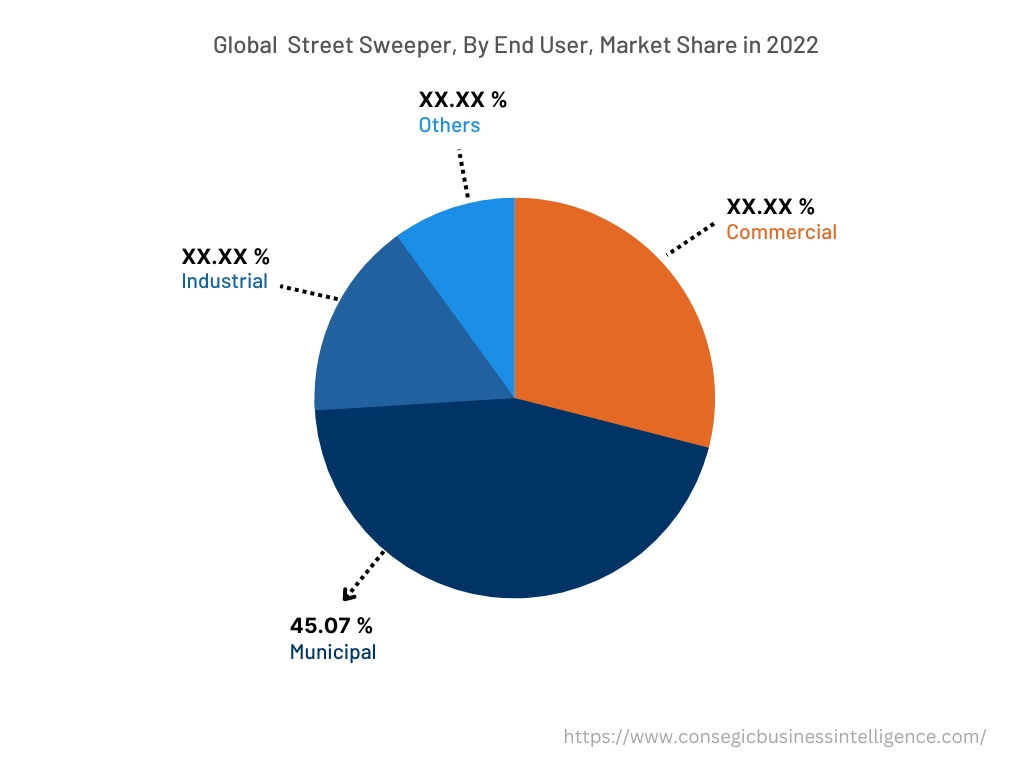
By Region :
The regional segment includes North America, Europe, Asia Pacific, the Middle East and Africa, and Latin America.
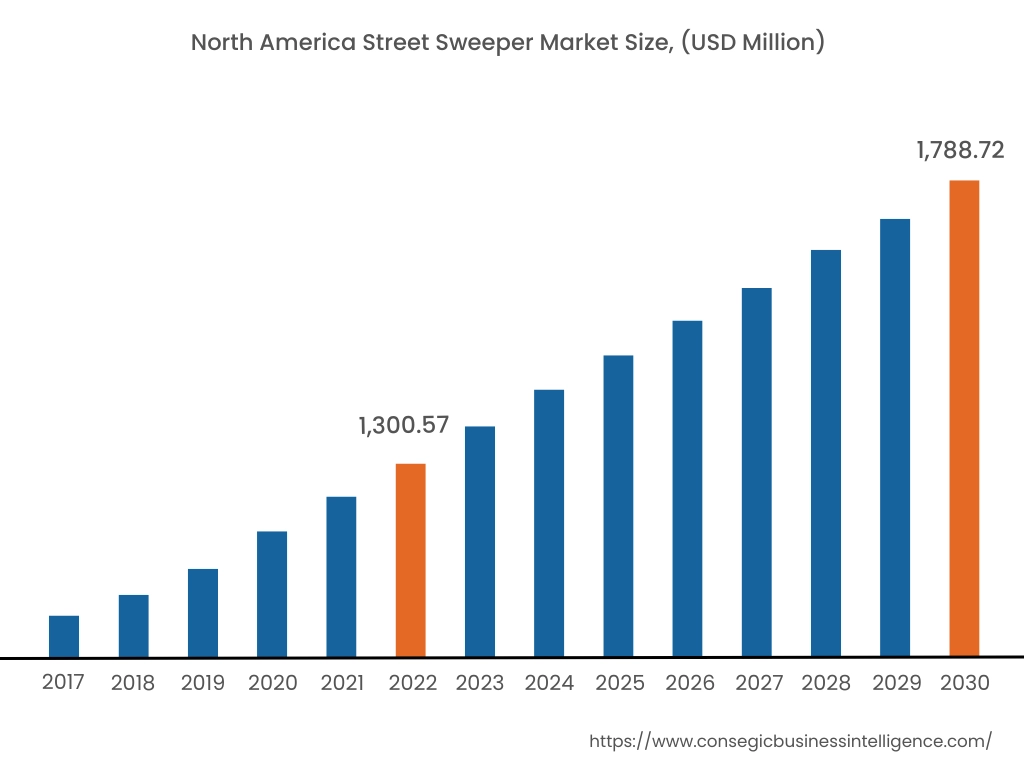
In 2022, North America accounted for the highest market share of 35.50% valued at USD 1,300.57 million, and is expected to reach USD 1,788.72 million in 2030. In the North American region, the U.S. accounted for the highest market share of 68.80% during the base year 2022 owing to the growing emphasis on maintaining clean and sustainable environments. Additionally, the growing tourism rate in the region is another salient factor contributing to the demand for street sweepers. North America depends on tourism as one of the economic drivers, and street sweepers play a vital role in keeping the areas clean and inviting. For instance, the World Travel & Tourism Council's (WTTC) latest Economic Impact Report (EIR), reveals the North America Travel & Tourism industry is projected to grow at an average annual rate of 3.9% over the next decade, and is anticipated to amount to USD 3.1 trillion by 2032.
Moreover, Asia Pacific is expected to grow at the fastest CAGR of 4.9% during the forecast period due to rapid urbanization, with the growth of cities and towns leading to increased road infrastructure. In addition, increasing public health awareness has also contributed to the demand for street sweepers. For instance, according to the report published by the Asian Development Bank (ADB), more than 70% of the approximately 2.5 billion people at risk of contracting dengue worldwide live in Asia Pacific. Hence, as per the market trends analysis, the rise in the prevalence of such diseases has led to the growing adoption of street sweepers, in turn propelling the street sweeper market opportunities in the region.
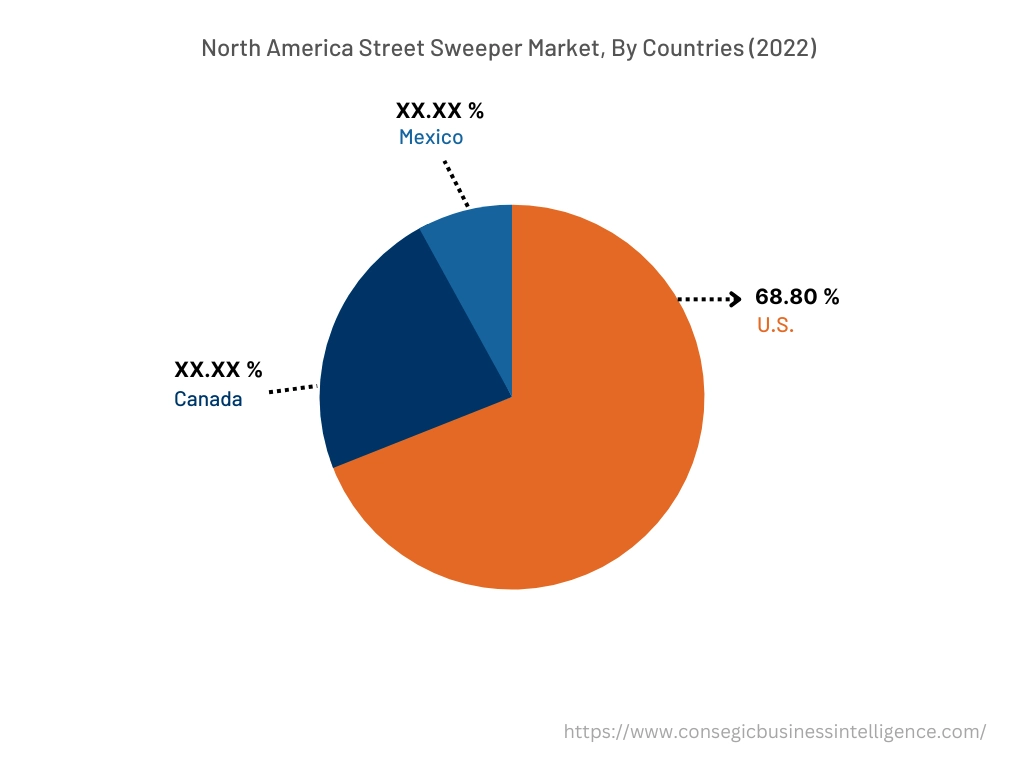
Top Key Players & Market Share Insights :
The Street Sweeper Market is highly competitive, with several large players and numerous small and medium-sized enterprises. These companies have strong research and development capabilities and a strong presence in the market through their extensive product portfolios and distribution networks. The market is characterized by intense competition, with companies focusing on expanding their product offerings and increasing their market share through mergers, acquisitions, and partnerships. The key players in the street sweeper industry include-
- Global Environmental Products
- BUCHER
- Alamo Group Inc.
- FULONGMA GROUP Co., Ltd.
- Alfred Kärcher SE & Co. KG
- FAYAT Group
- Aebi Schmidt Group
- Piquersa Maquinaria, S.A.
- Nilfisk Group
- Hako Machines Ltd
- Çeksan
Recent Industry Developments :
- In May 2021, the New York City Department of Sanitation unveiled a first-of-its-kind all-electric street sweeper produced by Global Environmental Products.
- In January 2021, Bucher acquired Emway, a developer of software and robotics solutions for autonomous utility vehicles with a focus on municipal sweepers.
Key Questions Answered in the Report
What was the market size of the street sweeper market in 2022? +
In 2022, the market size of street sweepers was USD 3,663.58 million.
What will be the potential market valuation for the street sweeper market by 2030? +
In 2030, the market size of street sweepers is expected to reach USD 5,020.25 million.
What are the key factors driving the growth of the street sweeper market? +
Growing public health concerns in various regions have augmented the demand for street sweepers.
What is the dominating segment in the street sweeper market by product type? +
In 2022, the mechanical broom sweeper segment accounted for the highest market share in the overall street sweeper market.
Based on current market trends and future predictions, which geographical region will have the fastest impact on the street sweeper market's growth in the coming years? +
Asia Pacific is expected to be the fastest-growing region in the market during the forecast period.
